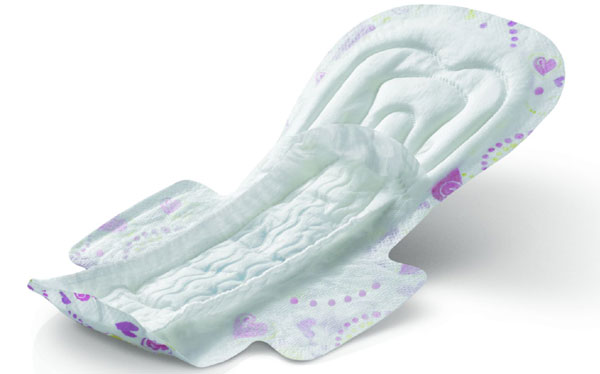
World War 1 led to the invention of disposable menstrual pads. While working in France, American nurses discovered that the bandages they used for the troops could easily double as absorbent menstrual pads. This discovery led to the bandage company to introduce disposable menstrual pads in 1921. But what exactly is IN a disposable pad today? Disposable pad and tampon companies are not required to list the ingredients in their products so we can’t say for sure, but we do know they are filled with chemicals (which we’ve been trying our hardest to avoid)!
Menstrual pads are always changing to be softer, more absorbent and thinner. Unfortunately, that means they’re made with new chemicals we don’t know much about. To start, let’s break down the general composition of today’s disposable pad. The absorbent layers are made with cellulose, combined with super absorbent polymer powder. Polymer is a fluid absorbing chemical derived from petroleum or wheat. When soaking up liquid, polymer powder turns into a gel. Cellulose, (also known as rayon,) is the fiber that makes up the cell wall of trees and plants. The cellulose is then ground and moistened to make a product called pulp. Cellulose pulp is shredded into a fine fluff which is sprinkled with polymer powder. The fluff combination is then measured and molded into the correct shape for a pad. Generally two layers are made for a “regular” flow pad. These two layers are sandwiched between plastic sheets. The top layer is perforated to allow liquid to pass through to the absorbent layer while the bottom layer is left solid to prevent any leaks.
Pads also have odor control added to the absorbent layers mentioned above or sandwiched between two absorbent layers of a pad. Their ingredients include: active carbon, active silica, active alumina, ion exchange resin and chlorophyll. It doesn’t stop at just the pad. The cover (or top of the pad) also includes: sodium potassium aluminosilicate, sodium bicarbonate and carbonates, bicarbonates, phosphates and biphosphates, sulfates and bisulphates, ascorbic acid, boric acid, citric acid and maleic acid. If you buy a scented pad, it also includes alcohols and fragrance additives.
What exactly does all that mean? It means that one-quarter of our child bearing years we are in direct contact with chemicals known to cause cancer. Chemicals that cause cramps, nausea and vomiting. Chemicals that leave some of us with a lovely rash on our bum. And, plastics that can lead to an array of infections.
So what should we do? Let’s take a look at cloth pads! They are made with safe materials and they work. There are many brands to choose from or you can even make your own. Not only will you avoid the chemicals and side effects of disposable menstrual pads, you will save a lot of money and you will save the environment. A typical woman uses 8,000-10,000 pads in a lifetime which equates to 300 pounds in a landfill! The average savings over a lifetime is $2600-$5000! I can think of a lot of things I would rather do with that money!
And now you know. I hope this article opens your eyes to the side effects and risk factors conventional disposable menstrual pads have on your health and the environment. Maybe you will even reconsider the product that you are using. You can do your research and choose something that fits your lifestyle.
Would you consider using a cloth reusable menstrual pad?
